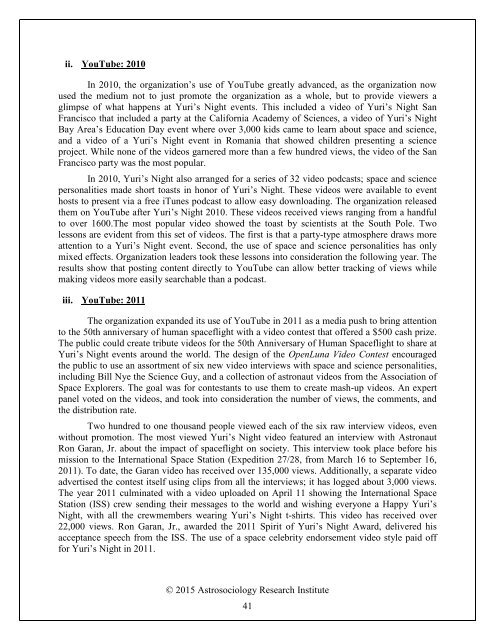THE JOURNAL OF ASTROSOCIOLOGY VOLUME 1
qd9nb3s
qd9nb3s
- No tags were found...
You also want an ePaper? Increase the reach of your titles
YUMPU automatically turns print PDFs into web optimized ePapers that Google loves.
ii. YouTube: 2010In 2010, the organization’s use of YouTube greatly advanced, as the organization nowused the medium not to just promote the organization as a whole, but to provide viewers aglimpse of what happens at Yuri’s Night events. This included a video of Yuri’s Night SanFrancisco that included a party at the California Academy of Sciences, a video of Yuri’s NightBay Area’s Education Day event where over 3,000 kids came to learn about space and science,and a video of a Yuri’s Night event in Romania that showed children presenting a scienceproject. While none of the videos garnered more than a few hundred views, the video of the SanFrancisco party was the most popular.In 2010, Yuri’s Night also arranged for a series of 32 video podcasts; space and sciencepersonalities made short toasts in honor of Yuri’s Night. These videos were available to eventhosts to present via a free iTunes podcast to allow easy downloading. The organization releasedthem on YouTube after Yuri’s Night 2010. These videos received views ranging from a handfulto over 1600.The most popular video showed the toast by scientists at the South Pole. Twolessons are evident from this set of videos. The first is that a party-type atmosphere draws moreattention to a Yuri’s Night event. Second, the use of space and science personalities has onlymixed effects. Organization leaders took these lessons into consideration the following year. Theresults show that posting content directly to YouTube can allow better tracking of views whilemaking videos more easily searchable than a podcast.iii. YouTube: 2011The organization expanded its use of YouTube in 2011 as a media push to bring attentionto the 50th anniversary of human spaceflight with a video contest that offered a $500 cash prize.The public could create tribute videos for the 50th Anniversary of Human Spaceflight to share atYuri’s Night events around the world. The design of the OpenLuna Video Contest encouragedthe public to use an assortment of six new video interviews with space and science personalities,including Bill Nye the Science Guy, and a collection of astronaut videos from the Association ofSpace Explorers. The goal was for contestants to use them to create mash-up videos. An expertpanel voted on the videos, and took into consideration the number of views, the comments, andthe distribution rate.Two hundred to one thousand people viewed each of the six raw interview videos, evenwithout promotion. The most viewed Yuri’s Night video featured an interview with AstronautRon Garan, Jr. about the impact of spaceflight on society. This interview took place before hismission to the International Space Station (Expedition 27/28, from March 16 to September 16,2011). To date, the Garan video has received over 135,000 views. Additionally, a separate videoadvertised the contest itself using clips from all the interviews; it has logged about 3,000 views.The year 2011 culminated with a video uploaded on April 11 showing the International SpaceStation (ISS) crew sending their messages to the world and wishing everyone a Happy Yuri’sNight, with all the crewmembers wearing Yuri’s Night t-shirts. This video has received over22,000 views. Ron Garan, Jr., awarded the 2011 Spirit of Yuri’s Night Award, delivered hisacceptance speech from the ISS. The use of a space celebrity endorsement video style paid offfor Yuri’s Night in 2011.© 2015 Astrosociology Research Institute41


